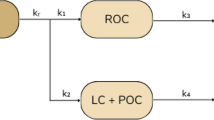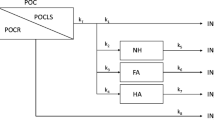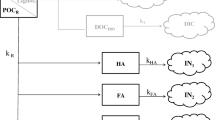Abstract
This study compared the decomposition of particulate organic carbon (POC) of two macrophyte species under four nutrient conditions and its fate within the aquatic system. Samples of aquatic macrophytes and water were collected from Barra Bonita Reservoir (São Paulo State, Brazil). Dissolved organic matter was leached from the plant material. Incubations were prepared with POC, inoculums and water from the reservoir, simulating different nutrient concentrations with the same N:P ratio. POC was quantified, enzymatic activity was measured, and nutrient concentrations and fiber contents were analyzed. A kinetic model was adopted to explain and compare the carbon decay. The fitting of the kinetic model showed biphasic decay for both species, indicating two classes of compounds: a reactive organic resource and a recalcitrant resource. The reactive organic resource breakdown (k ROC = 0.1 day−1) generated a dissolved fraction, which was consumed according to detritus quality (Paspalum repens; k 3 = 0; Pistia stratiotes; k 3 ranging from 8 × 10−4 to 0.013 day−1). The slow mass loss of the recalcitrant resource is related to the high nutrient concentrations that improved enzymatic activity and fiber decay. The yields of the different routes of carbon POC derived depend on both detritus quality and environmental nutrient conditions.









Similar content being viewed by others
References
AES Tietê. http://www.aestiete.com.br/usinas/Paginas/BarraBonita.aspx. Accessed Feb 2013
Berg B, Mc Claugherty C (2008) Plant litter decomposition, humus formation, carbon sequestration. Springer, Germany
Best EPH, Dassen JHA, Boon JJ, Weigers G (1990) Studies on decomposition of Ceratophyllum demersum under laboratory and field conditions: loss of dry mass and nutrients, quantitative changes in organic compounds and consequences for ambient water and sediment. Hydrobiologia 194:91–114
Bianchini I Jr (2003) Modelos de crescimento e decomposição de macrófitas aquáticas. In: Thomaz SM, Bini LM (eds) Ecologia e manejo de macrófitas aquáticas. Eduem, Maringá, pp 85–126
Bianchini I Jr, Cunha-Santino MB (2011) Model parameterization for aerobic decomposition of plant resources drowned during man-made lakes formation. Ecol Model 222:1263–1271
Bianchini I Jr, Cunha-Santino MB, Panhota RS (2011) Oxygen uptake from aquatic macrophyte decomposition from Piraju Reservoir (Piraju, SP, Brazil). Braz J Biol 71:27–35
Blagodastskaya E, Khomyakov N, Myachina O, Bogomolova I, Bladodatsky S, Kuzyakov Y (2014) Microbial interactions affect priming induced by cellulose. Soil Biol Biochem 74:39–49
Calijuri MC, Dos Santos ACA, Jati S (2002) Temporal changes in the phytoplankton community structure in a tropical and eutrophic reservoir (Barra Bonita, SP—Brazil). J Plankton Res 24(7):617–634
Carvalho FT, Gallo MLBT, Velini ED, Martins D (2003) Plantas aquáticas e nível de infestação das espécies presentes no reservatório de Barra Bonita, no Rio Tietê. Planta Daninha 21:15–19
CETESB Companhia de Tecnologia de Saneamento Ambiental. Relatório de Qualidade das águas Interiores do Estado de São Paulo. www.cetesb.gov.br/agua/rios/publicacoes.asp. Accessed Aug 2012
Chambers PA, Lacoul P, Murphy KJ, Thomaz SM (2008) Global diversity of aquatic macrophytes in freshwater. Hydrobiologia 595:9–26
Cunha-Santino MB, Gouvêa SP, Bianchini I Jr, Vieira AAH (2008) Oxygen uptake during mineralization of photosynthesized carbon from phytoplankton of Barra Bonita: a mesocosm study. Braz J Biol 68:115–122
Farjalla VF, Azevedo DA, Esteves FA, Bozelli RL, Roland F, Enrich-Prast A (2006) Influence of hydrological pulse on bacterial growth and DOC uptake in a clear-water Amazonian lake. Microb Ecol 52:334–344
Geurts JJM, Smolders AJP, Banach AM, Van De Graaf JPM, Roelofs JGM, Lamers LPM (2010) The interaction between decomposition, net N and P mineralization and their mobilization to the surface water in fens. Water Res 44:3487–3495
Ghose TK, Bisaria VS (1987) Measurement of hemicellulase activities part 1: xylanases. Pure Appl Chem 59:1739–1752
Gilbert HJ, Hazelwood GP (1993) Bacterial cellulases and xylanases. J Gen Microbiol 139:187–194
Golterman HL, Clymo RS, Ohnstad MAM (1978) Methods for physical and chemical analysis of freshwaters, 2nd edn. Blackwell, Oxford
Gonçalves JF Jr, Graça MAS, Callisto M (2007) Litter decomposition in a cerrado savannah stream is retarded by leaf toughness, low dissolved nutrients and low density of shredders. Freshw Biol 52:1440–1451
Güsewell S, Gessner MO (2008) N:P ratios influence litter decomposition and colonization by fungi and bacteria in microscosm. Funct Ecol 23:211–219
Hee CA, Pease TK, Alperin MJ, Martens CS (2001) Dissolved organic carbon production and consumption in anoxic marine sediments: a pulsed-tracer experiment. Limnol Oceanogr 46:1908–1920
Hobbie SE (2008) Nitrogen effects on decomposition: a five-year experiment in eight temperate sites. Ecology 89:2633–2644
Howard-Williams C, Junk WJ (1976) The decomposition of aquatic macrophytes in the floating meadows of a central Amazonian várzea lake. Biogeographica 7:115–123
INMET—Brazilian Institute of Meteorology. http://www.inmet.gov.br. Accessed Oct 2012
Lan Y, Cui B, Zheyuan Y, Li X, Zhang Y, Zhang Y (2012) Litter decomposition of six macrophytes in an eutrophic shallow lake (Baiyangdian Lake, China). Soil Air Water 40:1159–1166
Li X, Cui B, Yang Q, Tian H, Lan Y, Wang T, Han Z (2012) Detritus quality controls macrophyte decomposition under different nutrient concentrations in a eutrophic shallow lake, North China. PLoS ONE 7:1–10
Li X, Cui B, Yang Q, Lan Y, Wang T, Han Z (2013) Effects of plant species on macrophyte decomposition under three nutrient conditions in a eutrophic shallow lake, Noth China. Ecol Model 252:121–128
Mandels M, Andreotti R, Roche C (1975) Measurement of saccharifying cellulose. Biotechnol Bioeng Symp 6:1–33
Moran MA, Hodson RE (1989) Formation and bacterial utilization of dissolved organic carbon derived from detrital lignocelluloses. Limnol Oceanogr 62:1034–1047
Møller J, Miller M, Kjøller A (1999) A fungal–bacterial interaction on beech leaves: influence on decomposition and dissolved organic carbon quality. Soil Biol Biochem 31:367–374
Nunes MF, Cunha-Santino MB, Bianchini I Jr (2011) Xylanase and cellulase activities during anaerobic decomposition of three aquatic macrophytes. Braz J Microbiol 42:75–83
Pérez J, Muñoz-Dorado J, Rubia T, Martinez J (2002) Biodegradation and biological treatments of cellulose, hemicellulose and lignin: an overview. Int Microbiol 5:53–63
Qu X, Xie L, Lin Y, Bai Y, Zhu Y, Xie F, Giesy JP, Wu F (2013) Quantitative and qualitative characteristics of dissolved organic matter from eight dominant aquatic macrophytes in Lake Dianchi, China. Environ Sci Pollut Res Int 20:7413–7423
Rejmánková E, Houdková K (2006) Wetland plant decomposition under different nutrient conditions: what is more important, litter quality or site quality? Biochemistry 80:245–262
Rejmánková E, Sirová D (2007) Wetland macrophyte decomposition under different nutrient conditions: relationship between decomposition rate, enzyme activities and microbial biomass. Soil Biol Biochem 39:526–538
Sarneel JM, Geurts JJM, Beltman B, Lamers LPM, Nijzik MM, Soons MB, Verhoven JTA (2010) The effect of enrichment of either the bank or the surface water on shoreline vegetation and decomposition. Ecosystems 13:1275–1286
Somogyi M (1952) Notes on sugar determination. J Biol Chem 195:19–23
Stevenson FJ (1982) Humus chemistry: genesis, composition, reactions. Wiley, New York, p 512
Van Soest PJ, Wine RH (1967) Use of detergents in the analysis of fibrous feeds. IV. Determination of plant cell wall constituents. J Assoc Off Anal Chem 50:50–55
Vollenwider A (1983) Scientific fundamentals of the eutrophication of lakes and flowing waters, with particular reference to nitrogen and phosphorus as factors in eutrophication. Organization for Economic Cooperation and Development, Paris
Wetzel RG (1995) Death, detritus and energy flow in aquatic systems. Freshw Biol 33:83–89
Wetzel RG, Likens GE (1991) Limnological analysis. Springer, New York
Acknowledgments
We thank FAPESP for their financial support (Fundação de Amparo à Pesquisa do Estado de São Paulo, Process number 2012/21829-0).
Author information
Authors and Affiliations
Corresponding author
Rights and permissions
About this article
Cite this article
Bottino, F., Cunha-Santino, M.B. & Bianchini, I. Decomposition of Particulate Organic Carbon from Aquatic Macrophytes Under Different Nutrient Conditions. Aquat Geochem 22, 17–33 (2016). https://doi.org/10.1007/s10498-015-9275-x
Received:
Accepted:
Published:
Issue Date:
DOI: https://doi.org/10.1007/s10498-015-9275-x




